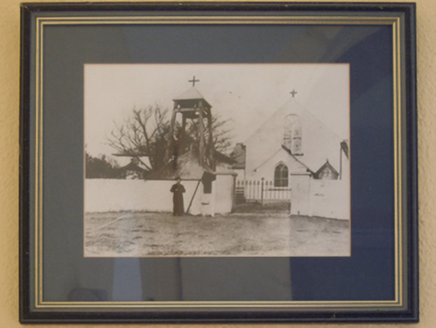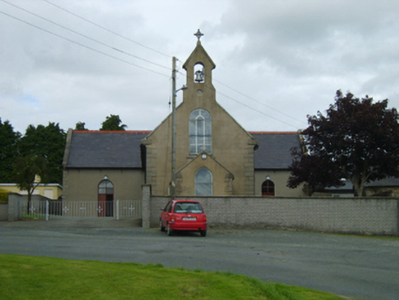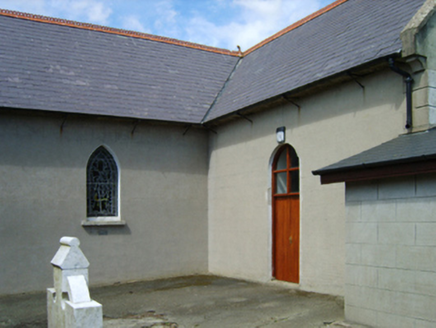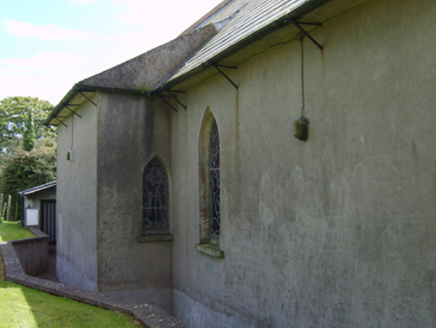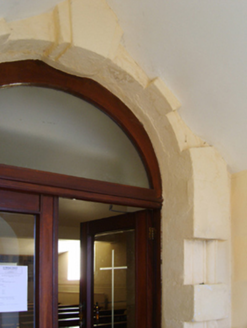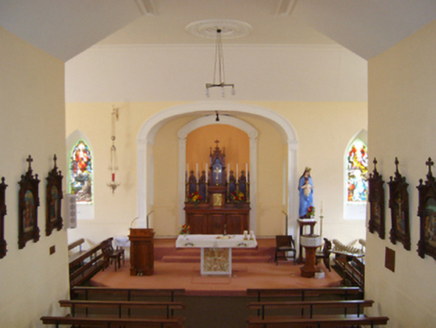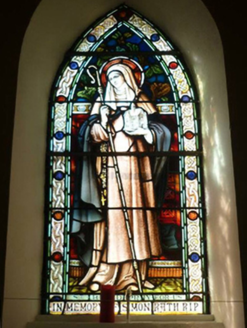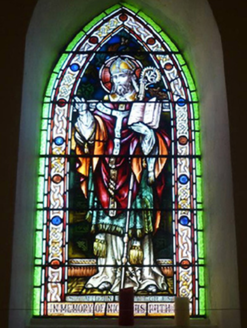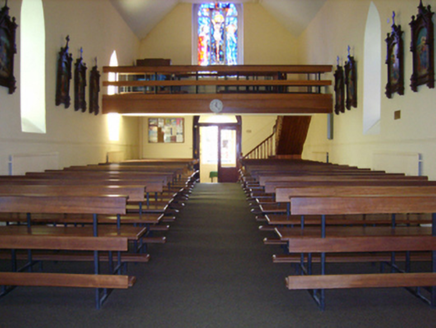Survey Data
Reg No
15701632
Rating
Regional
Categories of Special Interest
Architectural, Artistic, Historical, Social
Original Use
Church/chapel
In Use As
Church/chapel
Date
1825 - 1830
Coordinates
312065, 146321
Date Recorded
08/09/2007
Date Updated
--/--/--
Description
Detached four-bay double-height Catholic church, built 1828, on a cruciform plan comprising two-bay double-height nave opening into single-bay (single-bay deep) double-height transepts centred on single-bay double-height shallow chancel to crossing (north) with single-bay single-storey gabled projecting porch to entrance (south) front. "Improved", 1903, producing present composition. Renovated, ----, with sanctuary reordered. Pitched slate roof on a cruciform plan centred on lean-to slate roof (north) with pitched (gabled) slate roof (porch), trefoil-perforated crested terracotta ridge tiles, lichen-covered coping to gables on rendered "Cavetto" kneelers including lichen-covered coping to gable to entrance (south) front on rendered "Cavetto" kneelers with rendered, ruled and lined buttressed gabled bellcote to apex, and cast-iron rainwater goods on slightly overhanging rendered slate flagged eaves retaining cast-iron downpipes. Rendered, ruled and lined walls with rusticated rendered quoins to corners. Pointed-arch window openings with cut-granite sills, and concealed dressings framing storm glazing over fixed-pane fittings having stained glass margins centred on leaded stained glass panels. Round-headed window to entrance (south) front with cut-granite sill, and concealed dressings framing storm glazing over fixed-pane fittings having leaded stained glass panels. Interior including vestibule (south) with stained glass window (1903); segmental-headed door opening into nave with cut-granite block-and-start surround centred on double keystone framing replacement glazed timber double doors overlight; full-height interior with choir gallery (south) below stained glass "South Window" (----), carpeted central aisle between replacement timber pews, grouped Gothic-style timber stations centred on stained glass memorial windows (1901), stained glass memorial windows (1901) centred on carpeted stepped dais to sanctuary to crossing (north) reordered, ----, with Gothic-style timber panelled high altar in elliptical-headed alcove, and moulded plasterwork cornice to vaulted ceiling centred on "Acanthus"-detailed plasterwork ceiling rose. Set in landscaped grounds.
Appraisal
A church representing an integral component of the early nineteenth-century ecclesiastical heritage of County Wexford with the architectural value of the composition, one showing the hallmarks of a period of construction coinciding with the dismantling of the Penal Laws under the Roman Catholic Relief Act, 1829, confirmed by such attributes as the cruciform plan form, aligned along a liturgically-incorrect axis; the "pointed" profile of the openings underpinning a streamlined Georgian Gothic theme; and the handsome bellcote embellishing the roofline as a picturesque eye-catcher in the landscape: meanwhile, aspects of the composition clearly illustrate the continued development or "improvement" of the church at the turn of the twentieth century. Having been well maintained, the elementary form and massing survive intact together with substantial quantities of the historic or original fabric, both to the exterior and to the interior reordered (----) in accordance with the liturgical reforms sanctioned by the Second Ecumenical Council of the Vatican (1962-5) where contemporary joinery; stained glass signed by Joshua Clarke and Sons (opened 1892) of North Frederick Street, Dublin; a "flèche"-topped reredos; and decorative plasterwork enrichments, all highlight the artistic potential of a church making a pleasing visual statement in a rural village street scene.
